As an Amazon Associate I earn from qualifying purchases.
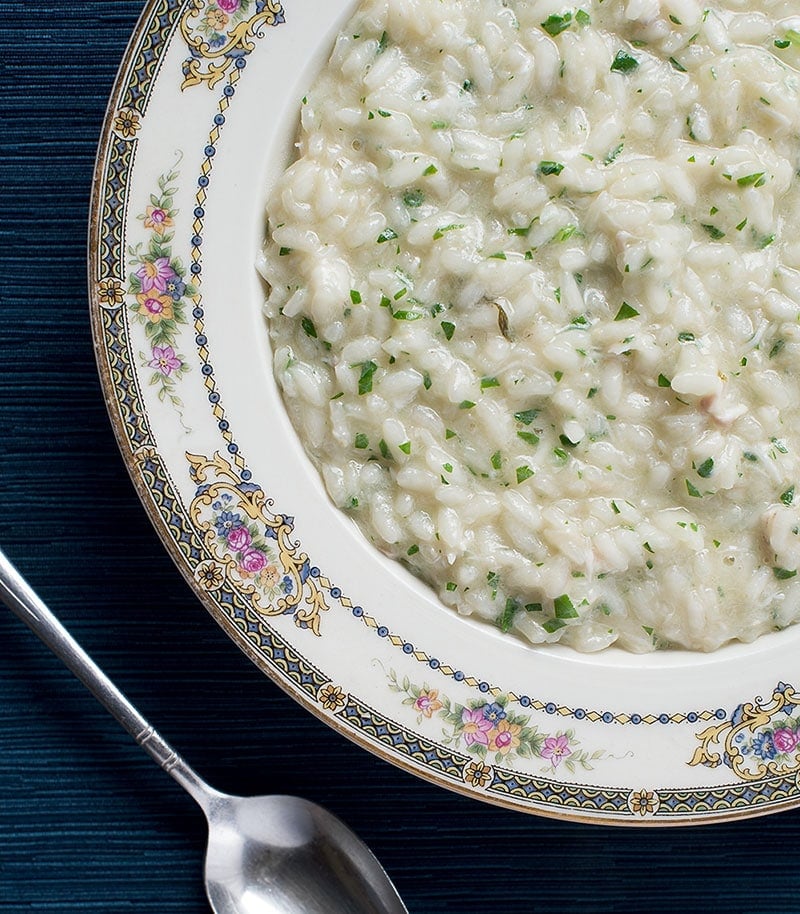
If there is one episode of Anthony Bourdain’s “No Reservations” that sticks with me, it is his trip to Venice. In that episode he has risotto di go, an ethereal dish that hinges on a magical fish broth, made from gobies.
Called “go” in Venetian dialect, a goby is a tiny little fish that’s no good for anything but making broth. Any true, authentic risotto di go must have the goby from the Venetian lagoons.
Alas, this is impossible outside Venice. But the technique of making this risotto is repeatable — and unforgettable.
No matter what fish you make it with, a Venetian fish risotto is always a little soupy, always hinges on a rich, pampered broth, and is almost always as white as a virgin mind. It is one of the most beautiful things you can create from such humble beginnings.
Done perfectly, a bowl of this risotto will restore your faith in humankind and make you misty with thoughts of a simpler age, a quieter time.
It all begins with the broth. You cannot make a great fish risotto with anything other than fish broth made immediately prior to making the risotto. Yes, you can make passable ones with broth from a few days ago, thawed broth or even a little clam juice. But it will not be the same. Not by a longshot.
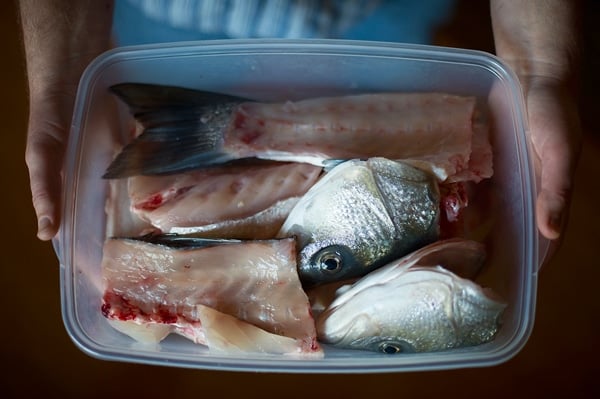
Clean, golden fish broth is why risotto di go or any other good fish risotto is such a beloved dish. Heads, backbones, fins all go into the pot; only the guts and gills, which are bitter, are tossed away for the seagulls. Look at the eyes on these striped bass: So pretty, so crystalline. To throw them away would be a sin.
In fact, the first thing I made after I caught these fish was broth for risotto — the fillets could wait.
This is not a difficult recipe to make. And you can make it no matter where you live, as most any white, lean fish will work. What’s more, the fish broth you need for it comes together in less than an hour. It’s the method for making the risotto that takes time to perfect.
But this is one of a very few fish cooking techniques that everyone should master.
After all, who wouldn’t want to make magic from little more than rice and a bucket of bones?
If you’re looking for more risotto recipes, I have more than a dozen for fish and seafood, mushrooms and vegetables – you can check them out here.
Fish Risotto, Venice Style
Ingredients
BROTH
- About 2 to 3 pounds of fish heads, bones and fins, gills removed
- 3 tablespoons olive oil
- 2 celery stalks, chopped
- 1 large onion, chopped
- 1 fennel bulb, both bulb and fronds, chopped
- 4 garlic cloves, minced
- 2 tablespoons green peppercorns
- 3 bay leaves
- 1/2 cup chopped parsley
- Salt to taste
RISOTTO
- 2 tablespoons olive oil
- 1 large shallot, minced
- 2 garlic cloves, minced
- 1 1/2 cups risotto rice
- 1 cup white wine
- Salt
- About 1 cup flaked fish meat
- 2 tablespoons unsalted butter
- 1/4 cup finely grated parmesan cheese
- 1 tablespoon lemon juice
- 2 tablespoons minced parsley
Instructions
BROTH
- Bring a pot of water to a boil and drop in all the fish heads and bones. Let this return to a boil and cook for 5 minutes. Turn off the heat and discard the water. Pick off about 1 cup of fish from the carcasses and heads and set aside in the fridge.
- Clean the pot or use another, and heat the olive oil over medium-high heat. Saute the celery, onion and fennel bulb for 3 to 5 minutes, stirring often. Do not let it brown. Add the minced garlic and cook another minute.
- Add the blanched fish carcasses, green peppercorns, bay leaves and parsley and cover with enough water to submerge everything by 1 inch. Bring to a bare simmer, then drop the heat a little until the broth is just steaming, about 160°F. Add salt to taste. Let this cook gently like this for 45 minutes to 1 hour.
RISOTTO
- Once the broth has been cooking for 45 minutes, start the risotto. Heat the olive oil in a medium pot over medium-high heat. Saute the shallots for about 90 seconds, until they turn translucent. Add the garlic and cook another minute. Add the risotto rice and stir to combine. Cook, stirring often, for 3 to 4 minutes.
- While the rice is cooking, get a fine-meshed sieve and a ladle ready. Add the white wine to the risotto and stir to combine. The rice will almost immediately absorb it. When the pot is nearly dry, add two ladles of the fish broth -- poured through the strainer to make sure all that's in the risotto is broth, not debris.
- Stir the risotto almost constantly until the rice absorbs the broth. Taste for salt and add a little if needed. Repeat this process of adding a ladle or two of strained broth and stirring until it has absorbed until the rice is fully cooked, but still al dente. You want it just past the point where there is a little chalkiness at the center of each grain of rice. This normally takes 35 minutes or so.
- When the rice is ready, stir in the remaining ingredients. The risotto will tighten up, so add a final ladle of fish broth right before you serve. This risotto needs to be a little soupy; the Italian term is all'onda, or "under the waves."
Notes
Nutrition
Nutrition information is automatically calculated, so should only be used as an approximation.

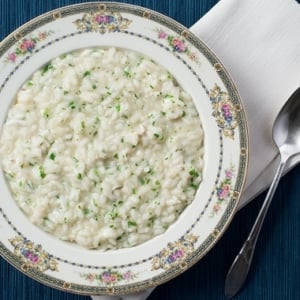
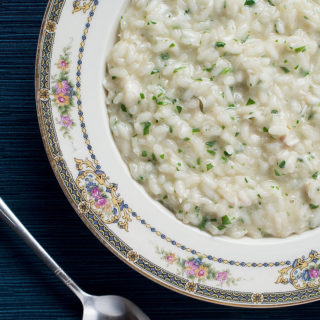
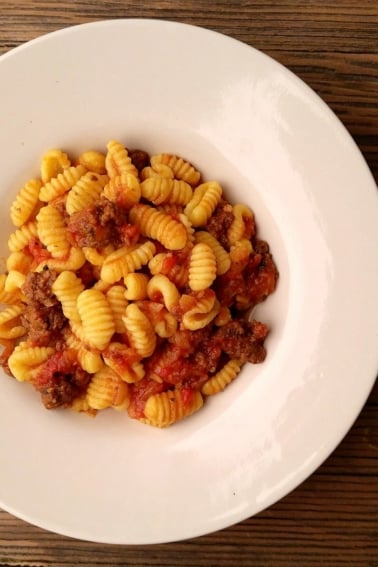

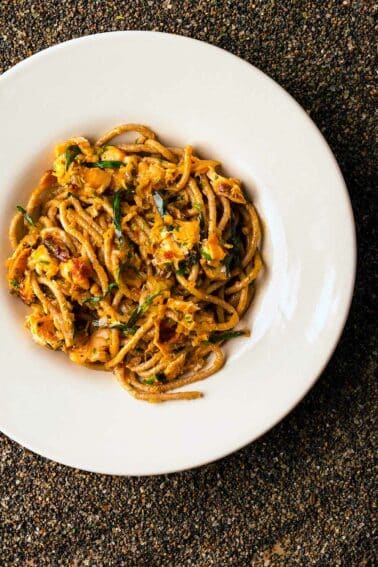
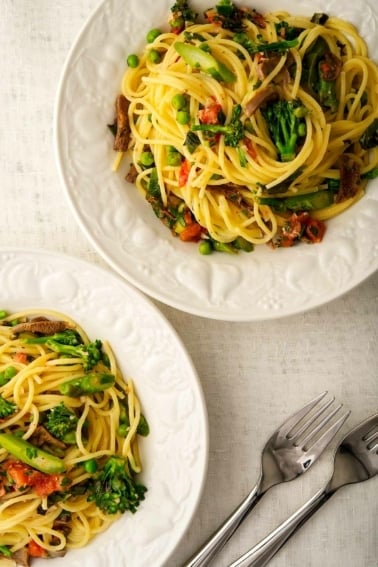
Well that was absolutely delicious.
I had fish stock so it cut the time down considerably.
The recipe, as is, is perfection.
Wow! This came out great!
I used a bunch of lingcod bits and parts to make the broth. I didn’t have fennel but I did add one star anise pod when making the broth. I was a little leary about that but it really added a nice subtle flavor. For the flaked fish I sauteed some ling and calico bass that I added at the end. Willl definetly being making this recipe again!
Now I need to find something else spectacular to make for dinner tonight with the remaining broth. Hmmm….
I’ve made this many times and it is always amazing. I prefer to cook my fish whole whenever possible, but this is an excellent way to use up any fish carcasses you may have. I’m often able to get carcasses either for free or for almost nothing from the fish sellers at our local farmers market. The only issue is that I always end up with a ton of unused broth after making. Although Hank is right that it’s best with the freshly made broth, the recipe still works great using frozen broth and leftover fish. Many thanks.
Winner, winner fish dinner!
Before trying this I was actually planning to make Hank’s shrimp risotto, since we had some frozen shrimp we wanted to use up and it was a smash success when I’ve made it before.
However, I then realized we also had the shells from two large Dungeness crab in our freezer, waiting for a trip to the garbage can the night before trash day. And, after reading the introduction to the fish risotto recipe in Hook Line And Supper, and also having recently re-watched the Anthony Bourdain episode in Venice, I decided to try what for me was a big, and very successful experiment, since I’ve never made any kind of seafood stock before.
And, sSince I didn’t have any fish frames on hand, for the stock I used the crab shells, some shrimp shells also in “freezer garbage” status, plus the skin and bones from a 1 1/2 pound ling cod fillet frozen after a charter trip in British Columbia last summer, where we caught our limit.
I followed the stock recipe pretty closely, and in order to incorporate the cod meat, I blanched the fillet in the stock as it was simmering, to get it partially cooked, then flaked it up and added it to the risotto when it was just about done cooking.
Anyway, as noted it was a fabulous experiment, and one I wouldn’t have tried without the guidance provided by Hook Line And Supper, and it’s focus on flexibility. As I always say in my house after such efforts: Thank Hank!
I enjoyed this recipe, and anything that makes me think of the legendary Bourdain. We used striped bass heads and carcasses to make the stock here on the Maryland western shore of the Chesapeake Bay.
I noticed that Hank’s most recent book skips the parmesan on this recipe. I thought it was excellent with the parm added at the end.
Whipped this up the other night after my daughter and I caught some walleye. I now truly understand all the hype and excitement behind risotto. Seriously. Make this. It’s straight forward and if I can do it, anyone can. You will not be sad.
I was wondering like one of the other commenters, do you think the great lakes invasive round goby would be a reasonable facsimile of the venetian variety?
The recipe calls for “About 1 cup flaked fish meat”
Is this the meat from the fish you used for your broth?
Thanks
Mixy: It can be. That is what I often do. But you can use separate fish, too.
That is handy. Do you cook it separately and add it at the end? Or do you let the fish cook with the rice for a few minutes?
I want to try this very soon!
thanks
Mixy: I usually use flaked fish left over from making the stock.
oh, I understand now. So, I guess that the idea is for the fish to blend into the rice. Nice…
thanks Hank. I will do this this week.
What a wonderful dish! I made a mistake, though, by soaking the Arborio overnight in water; in the end, it absorbed a bit less broth and Riesling than I had expected.
Review the broth ingredients,it doesn’t said the amount of water to use or in the instructions.
Daisy: That’s on purpose. It all depends on your pot. You typically cover the ingredients by about 2 inches of water.
Don’t say “Orientals”
Matt, I don’t see why not. Heck the Orientals use anything that swims. I say give it a try and let us know what you have found them to be like. Just remember as Hank has said, remove the gills and guts first.
Matt: Wow. I wonder? Give it a go (so to speak) and let me know how it works! I would just gut the fish and pull out the gills and cook them whole.
I live on Lake Michigan, where the invasive round gobies have taken over and are easy to catch with a salmon egg on a small hook. I wonder, could you make this broth with those?